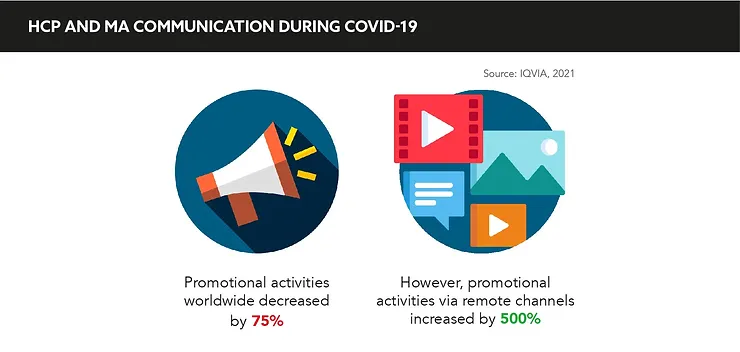Data has the power to disrupt the pharmaceutical industry, particularly in its approach to engaging key stakeholders. GOLD speaks to two industry experts – one marketer and one medical affairs professional – to discern the challenges facing data curation and use and speculate on where data is likely to drive the industry in the future
Interview with Megan Reutin, Global Head of Omnichannel Analytics, Grünenthal Group, and Dr John Wahba, Global Medical Affairs Director, Digital and Communications, ViiV Healthcare
What historical hurdles prevented the pharmaceutical industry from harnessing the data of stakeholders?
Reutin: A hurdle that we must navigate around is demonstrating the value of data. It’s easy to talk about the importance of data and the benefits, but until you can prove how impactful it is in a given situation, it’s hard to demonstrate the value. Good quality data is another potential hurdle. If the data used for insights is not of good quality, then it’s impossible to base business decisions on it. Another challenge can lay in data acquisition, which is as much about the way in which data is acquired as it is the granularity in which it can be obtained from different data sources, or even the same data source but from across different countries. Inconsistencies in data structures can lead to challenges when data blending. Data literacy across the business is also an absolute must. This doesn’t mean everyone needs to be a data scientist, they should just be able to understand the value and vision of data. Change management should aim to eradicate the fear and apprehension that surrounds data and artificial intelligence.
Wahba: Historically, there have been several hurdles to overcome, such as the availability of good quality and meaningful data; consent and data privacy laws, which can limit what and how much data can be collected and retained; data sharing and coordination; and the analysis of the data and what you do with it – or the ‘so what’. But the real hurdles can be if you do not have the right organisational mindset and strategy to invest in the appropriate infrastructure and resources to harness the power of data and analytics. Subsequently, it is also important to be able to track and measure the impact of these initiatives both on the organisation and on the stakeholders to gain valuable insights into what is working, what is not and how it can be improved.
What has been the impact of the pandemic on these challenges?
Reutin: The impact of the pandemic has been more around the differences in the volumes of data types that have been collected, as opposed to data in general. For example, the way that customers are being contacted has changed dramatically and this, coupled with remote working, meant that companies had to completely rethink the way in which they offered their products and services. The approach to customer interactions is now customer led and data driven. The race is officially on to find the optimal channel marketing mix for each industry, company, brand and country, but that is what’s exciting about it all.
Wahba: As the pandemic hit, organisations understandably were at different stages of digital maturity, and many were forced to accelerate their digital adoption journey. While for some this meant rethinking their digital priorities, for others it included the development or advancement of data and analytics capabilities to further support organisational decision making and improve outcomes for patients.
Change management should aim to eradicate the fear and apprehension that surrounds data and artificial intelligence
Where does most stakeholder mistrust lie and how can that be addressed?
Reutin: You can design the best technological solution in the world, but unless the data behind the scenes is of good quality, is consistent and easy to use then unfortunately the solution will be tarred with a black brush – this isn’t necessarily mistrust but that’s often the root of the issue. To avoid falling into this trap, any data solution or implementation needs to be addressed from a big-picture perspective. With a vision and objectives determining implementation in the first place, the reasoning behind an implementation should not be technology driven at all. One method that helps build trust is to co-create everything across a range of business stakeholders: solution objectives, metrics, output and impact measurement and so on. Co-creation allows visibility and builds trust in stakeholders from the very beginning.
Wahba: I would not say that mistrust is a big issue. I think there can sometimes be a lack of understanding of how analytics work and their potential, as well as ensuring that data is being utilised in a compliant and ethical way. It is therefore essential to collaborate early and work closely with our colleagues in the data and analytics and technology teams to align on the strategy and objectives of the work and ensure the appropriate governance and training is in place. The medical team can offer support by providing thought leadership and expertise around the clinical relevance of data sources, as well as shaping valuable use cases for data. This cross-functional collaboration is a key success factor in my organisation and ensures that we are agile in our approach.
Co-creation allows visibility and builds trust in stakeholders
How is data going to shape pharma’s future and which areas will see most of this momentum?
Reutin: Data is going to propel businesses forward in the areas that it hasn’t already. Companies that do not know how to make the most of their data will struggle to grow or even maintain current positioning on the market. The areas that will see the most focus will be everything that surrounds customers, especially items relating to customer experience. I also cannot wait to see further development in the use of synthesised data in illness diagnosis, as well as the development of early signal detection to eradicate certain illnesses that currently have no cure. We have proved that it’s feasible to fast track vaccine creation. Now we need to fast track cures for a plethora of illnesses that no one should have to fight against.
Wahba: Data and insights will be key to supporting and enhancing external scientific engagement in a more tailored and personalised way in terms of what content and which channels to utilise in order to address unmet medical needs. Data can also provide useful information to support more accurate mapping of our stakeholder journeys and allow us to explore relevant touch points with the greatest value and impact for our stakeholders. Eventually, as systems mature and evolve, machine learning and artificial intelligence can
be integrated to digest this data and augment its analysis.







